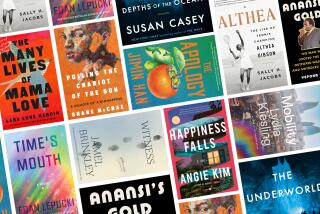Cut glass
- Share via
“The Palace of Illusions” by Chitra Banerjee Divakaruni is as sprawling and bright a gem as the Hope Diamond -- a mythic tale brimming with warriors, magic and treachery (and its brother, deceit). Let us not forget unrequited love, a must-have element in any heroic saga.
This ambitious novel recasts the Hindu epic “The Mahabharata,” said to be the world’s longest poem, which in its 220,000 lines chronicles a war between cousins who become rivals for their ancestral kingdom in central India. Written about 900 BC and divided into 18 sections, “The Mahabharata” is part historical record, part folklore and part holy text, containing within it “The Bhagavad-Gita,” which is sacred in Hinduism. Divakaruni’s story tells the epic from the point of view of Panchaali (also known as Draupadi), wife to all five of the Pandava brothers, who are the ultimate victors of the war. Imagine Homer’s “Odyssey” from the perspective of Penelope, say, or “The Iliad” as a memoir by Helen of Troy, and you get the idea.
Panchaali and her brother are born to a king, but in the way of any great myth, they don’t arrive typically: They step out of a fire, fully formed, hand in hand. An apt metaphor for such a heroine, whose beauty attracts like a flame but then seems to burn all those who come near her. From the moment she sets foot in the world, Panchaali knows her destiny is to change the course of history. How she will do this is not immediately evident.
As a young woman, she is helped along the way by the sage Vyasa, who is not only a character but also the author of “The Mahabharata,” not to mention grandfather to the Pandavas. (Indian myths are nothing if not torturously complicated.) He tells her that although she will be “queen of queens,” she was born to cause a great war and lead millions to their death, but if she follows his advice she can mitigate some of the damage. “Three dangerous moments will come to you,” he says. “The first will be at the time of your wedding: at that time, hold back your question. The second will be when your husbands are at the height of their power: at that time, hold back your laughter. The third will be when you’re shamed as you’d never imagined possible: at that time, hold back your curse.”
Panchaali, of course, does none of these and thus launches the conflicts and problems that are the stuff of all storytelling. When Maya, a trickster god, is hired as the architect for the palace she will live in with her five husbands, doom is clearly at hand. Doesn’t Panchaali know that the value of earthly things is merely an illusion? That an attachment to things leads to all suffering? Doesn’t she read Yoga Journal, for crying out loud?
Who better to attempt the feat of transforming a centuries-old cultural icon into a personal, modern story than Divakaruni, a professor of English at the University of Houston and author of numerous award-winning works, including the luscious novel “The Mistress of Spices” and the bestselling “Sister of My Heart.” Divakaruni’s sentences dazzle; the images she creates are masterful, as here when she renders a nightmare of Panchaali’s: “The palace walls buckle and fold. Lacquered tears flow down the cheeks of the gods . . . the palace explodes, a dark heart bursting. Those who run to look will later claim they saw a thousand insects soar into the sky on blazing wings.”
Yet despite the glorious images, the poetic sentences, the spiritual beauty of the tale’s moral, making an epic poem read like a novel is a piece of alchemy even Divakaruni can’t really pull off. “The Palace of Illusions” is indeed like the Hope Diamond, if you’ve ever seen it at the Smithsonian: impressive in its size and color but really not as faceted or luminous as you’d expect. The narration by the female protagonist feels not so much like an intimate revelation of a character as a voice recapping more exciting dramas that happened in a better story.
Condensing such a broad tale and span of years is bound to make some details fuzzy. Then there are all the polysyllabic names to keep straight. So many asides to things that happen parallel to the main story of Panchaali’s life dramas. So many allusions to Hindu theological concepts like Shiva, Vishnu and Vishnu’s incarnation, Krishna -- or is he something like an archangel? Or a Christ figure? Oh, it’s all so confounding! (Krishna, by the way, happens to be a central character here as in the original epic.)
Still, “The Palace of Illusions” proves to be a pretty thing, as its decorative hardcover design suggests. Perhaps Divakaruni knows this featherweight retelling is as close as many Westerners will ever get to experiencing the glory of India’s epic poem -- just as saying “Om” in a yoga class might be the only Sanskrit that some of us will ever know.


